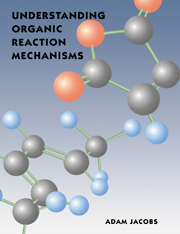Book contents
7 - Techniques for investigating mechanisms
Published online by Cambridge University Press: 05 June 2012
Summary
So far in this book, mechanisms of reactions have been presented as established truths. Although not all mechanisms are known with certainty, the mechanisms described here are generally thought to be accurate. Nonetheless, we should not forget that mechanisms of reactions are not handed down on tablets of stone, but are discovered by experiment. In this chapter we will look at some of the experimental techniques used for establishing mechanisms.
Basic principles
To specify the mechanism of a reaction, ideally we should know the precise positions of all atoms and the energy of all intermediates at every stage of the mechanism. In reality this ideal is seldom achieved, and we must usually be content with the gross features of a mechanism. Since we cannot look directly at atoms on the timescales of chemical reactions, we can never conclusively prove a mechanism to be correct. We can often prove mechanisms to be incorrect, and if we have ruled out all plausible alternatives to a particular idea, then this is usually seen as good evidence for it. This is not the same thing as proof, of course, since the true mechanism may be one that we have not considered.
To establish a mechanism with reasonable certainty, we normally have to carry out many experiments, as the result of any one experiment, even if it rules out some possible alternatives, will often be consistent with more than one mechanism. Quantum mechanical calculations have also been used to test the plausibility of reaction mechanisms.
- Type
- Chapter
- Information
- Understanding Organic Reaction Mechanisms , pp. 213 - 227Publisher: Cambridge University PressPrint publication year: 1997

